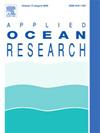Wave Energy Potential and the Role of Extreme Events on South America's Coasts. A Regional Frequency Analysis
IF 4.3
2区 工程技术
Q1 ENGINEERING, OCEAN
引用次数: 0
Abstract
This study examines wave energy potential and generation capacity from extreme waves along South America's Pacific and Atlantic coasts. Utilizing the Regional Frequency Analysis (RFA) method and the WAVERYS wave reanalysis model, 27 homogeneous regions with distinct wave patterns were identified. There's a notable southward increase in median and average wave heights and energy. Unlike previous studies, this research emphasizes the significant role of extreme wave events, which contribute up to 33 % of the total energy—a critical factor often overlooked in regional energy assessments. In the Pacific, three main zones were delineated, with energy peaks reaching 120 kW/m south of 50°S, while the Atlantic identified two zones with energy values ranging from 10 kW/m to 30 kW/m. Zones between 10°S to 40°S in the Pacific and 30°S to 60°S in the Atlantic stand out as particularly promising for energy harvesting. A comprehensive statistical methodology enabled predictions of wave heights and energy for 50 and 100-year return periods, predominantly utilized generalized Pareto and Gumbel distributions. The study affirms the efficacy of the RFA in improving the understanding of wave dynamics and highlights the necessity of integrating extreme events in energy assessments. This research provides a foundation for advancing wave energy initiatives and coastal risk mitigation in South America.
南美洲海岸的波浪能潜力和极端事件的作用。区域频率分析
本研究考察了南美洲太平洋和大西洋沿岸的波浪能潜力以及极端波浪的发电能力。利用区域频率分析(RFA)方法和 WAVERYS 波浪再分析模型,确定了 27 个具有独特波浪模式的同质区域。波浪的中值和平均高度及能量明显向南增加。与以往的研究不同,这项研究强调了极端波浪事件的重要作用,极端波浪事件占总能量的 33%--这是区域能量评估中经常被忽视的关键因素。在太平洋地区,划定了三个主要区域,南纬 50 度以南的能量峰值达到 120 kW/m,而大西洋则确定了两个区域,能量值从 10 kW/m 到 30 kW/m。太平洋介于南纬 10 度至 40 度和大西洋介于南纬 30 度至 60 度之间的区域尤其具有能量收集的前景。综合统计方法能够预测 50 年和 100 年重现期的波高和能量,主要利用广义帕累托分布和冈贝尔分布。这项研究肯定了 RFA 在提高对波浪动力学认识方面的功效,并强调了将极端事件纳入能源评估的必要性。这项研究为在南美洲推进波浪能计划和降低沿海风险奠定了基础。
本文章由计算机程序翻译,如有差异,请以英文原文为准。
求助全文
约1分钟内获得全文
求助全文
来源期刊

Applied Ocean Research
地学-工程:大洋
CiteScore
8.70
自引率
7.00%
发文量
316
审稿时长
59 days
期刊介绍:
The aim of Applied Ocean Research is to encourage the submission of papers that advance the state of knowledge in a range of topics relevant to ocean engineering.
 求助内容:
求助内容: 应助结果提醒方式:
应助结果提醒方式:


